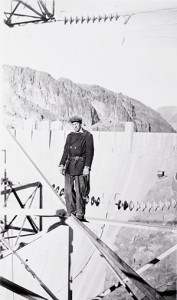
IBEW member Ralph Henderson on a steel beam above Boulder Dam (now Hoover Dam) in the 1930s, the era when PG&E was using a company union to defeat legitimate union organizing efforts. IBEW 1245 Archive
IBEW 151 had lost its labor agreement with PG&E in 1921, and by the early 1930s the union was a shadow of its former self. But in 1933, PG&E employees began organizing again. After the rise of the CIO these employees affiliated with the United Electrical and Radio Workers of America (UE) for a 1937 organizing drive at PG&E. The UE laid out an aggressive plan for collective bargaining that reflected the new and more militant spirit of the CIO.
The IBEW, still claiming about 200 members at PG&E, won a spot on the ballot. A third organization petitioned to be on the ballot as well: the California Gas & Electric Employees (CG&EE).
CG&EE looked like a real union, but in fact it was created by managers on April 16, 1937 in a PG&E Assembly Room in Sacramento. It was completely phony. A power salesman named Howard E. Brillhart was elected president. He was allowed to organize for this new union on company time, and to pursue employee grievances.
In November of 1937, the IBEW dropped out of the election. PG&E managers put heavy pressure on employees to vote for the company union. In December voting, the company union won. UE immediately filed charges with the National Labor Relations Board, claiming that PG&E had violated the law by organizing a sham union.
After the election, PG&E told Brillhart to be less aggressive in pursuing employee grievances. This began to erode Brillhart’s loyalty to management.